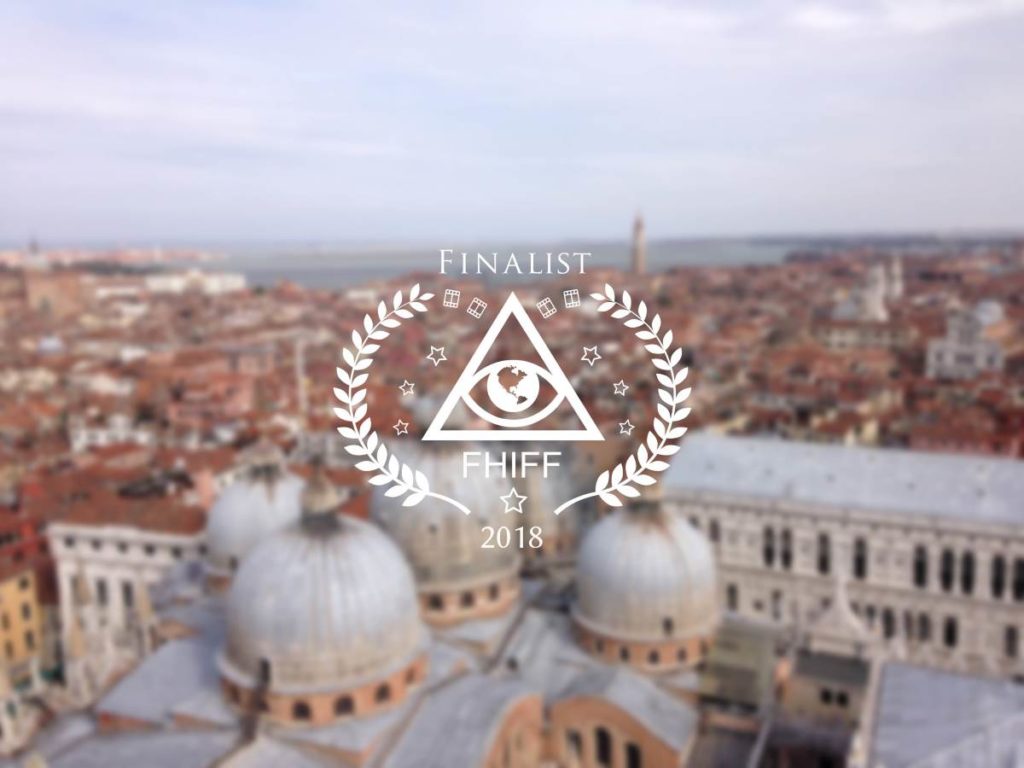
28 films made it into the list of finalists at the First Hermetic Film Festival 2018 in Venice
Not less than 28 films, most of them with open, some with more concealed hermetic or esoteric messages or symbols, were shown about two weeks ago on the First Hermetic International Film Festival in Venice, on the 1st and the 2nd of March 2018. A week ago I shared my first impressions and my personal favorites, today I am back with a complete list of the 28 finalists, including a description and – if available – a trailer for each. For some films, detailed and exclusive interviews with the filmmakers are already scheduled.
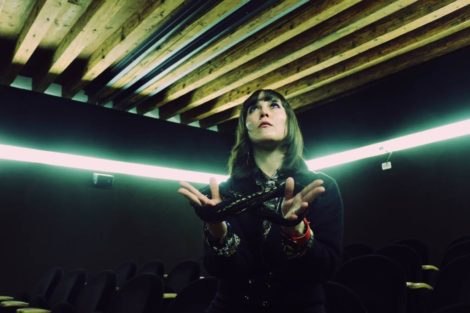
Happy with the feedback for the first edition of the Hermetic Film Festival: Director Sara Wundersaar Ferro
Festival director Sara Wundersaar Ferro (Italy) and Technical Director Chris Weil (Germany) are happy with the outcome. The expectations have been quite high, explains Sara for NettlesGarden.com, namely to unite a wide array of different subjects and cinematic approaches in order to document the plethora of different perspectives in contemporary esoterism. As the title of our festival suggests, our focus was hermeticism, but also had the explicit aim to include split-offs, parallel or even contradictory developments, as we also witness in history. Thus, the festival tried to be open to all kinds of esoteric approaches, even if they would not look very hermetic on first sight.
The selection criteria were not only regarding the contents, i.e. how well the film covers the topic or fits the manifesto, but also took formal criteria into account, such as the availability of all necessary intellectual property rights.
The feedback for the festival was very positive, explains Sara, and transmits her and Chris’ thanks on this way to all filmmakers, helpers, visitors and the team between the festival, who made the event possible.
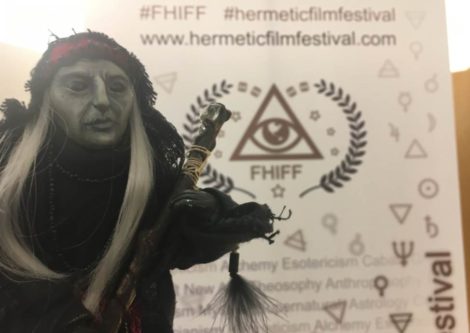
Witch Nettle will join again the next edition of the Hermetic Film Festival in 2019.
Meanwhile, Sara and Chris already plan the next edition for 1st and 2nd of March 2019. Witch Nettle already looks forward to joining again and revisit Venice. Whoever wants to submit a film can do so on the official festival website. Besides the basic requirements for the content including an appropriate cinematic and intellectual level and topical fit, intellectual property rights for all the entire opera, including images and sound are a necessary precondition because it would not be possible otherwise to show the film. English subtitles should be available, to overcome language barriers, but are not mandatory for submission and selection.
And here is our list of the 28 finalists and the 10 categories for 2018:
1 Esoteric Philosophies
The festival was divided into ten categories, and it was fun to reason whether they may correspond to the sephirot of the tree of live or not. In some cases, this works smoothly, in others, such as the first category it’s a bit of a challenge to find the correspondence. Anyways, all »Esoteric Philosophies« (the name of category 1) try to shed light on the very beginning, »primum mobile« and the primordial. This is where Kether comes in.
FURIO JESI – MAN FROM UTOPIA

© FURIO JESI – MAN FROM UTOPIA – All rights reserved. Via FHIFF.
»Furio Jesi – Man from Utopia«, directed by Carlo Trombino and Claudia Martino won the Paracelsus Award for the best feature documentary at FHIFF 2018. The Italian feature-length documentary of about 60 minutes explores the life of Furio Jesi. As the film was entirely in Italian the following wrap-up relies quite a bit on secondary research, but nevertheless, I can say the documentary seemed quite lively. Jesi was an »independent scholar« without a formal degree, writing on various topics such as Greek and Egyptian mythology, history and philology. The film explores the life of Jesi, who stemmed from a Jewish family, through the accounts of his friends and colleagues, as well as through footage of some of the most important places in Jesi’s life, such as Turin, where he was born, Palermo, where he taught towards the end of the 70s, and Genoa where he died at only 39 years old.
The documentary delves in the post-war history of Turin when Jesi and his colleagues were the leading cultural group in the country at the time. Colleagues and friends of Jesi, such as Gianni Vattimo, Giulio Schiavoni, Angelo D’Orsi, Claudio Vicentini, and Elisabetta Chicco, not only recount the history of that time, but also Jesi’s place in it.
Another emphasis is made on Jesi’s genius, his travels to study myths at their place of origins, and the philosophical notions he proposed like the »mythological machine« and »wordless ideas« which are explored alongside his fascinating relationship with academic education.
While he dropped out of school at 16, Jesi won a contest for a university chair at the University of Palermo in 1975, which made him one of the last academy teachers in the country to be appointed without a degree. The director of the film, Carlo Trombino sees this documentary as a method of documenting history outside of academic institutions, which is strongly linked to Jesi’s relationship with the academy and the history of Turin as a capital of culture. The film was entirely in Italian, without subtitles – I hope very much that they will follow.
Deeply Absurd Lucidity
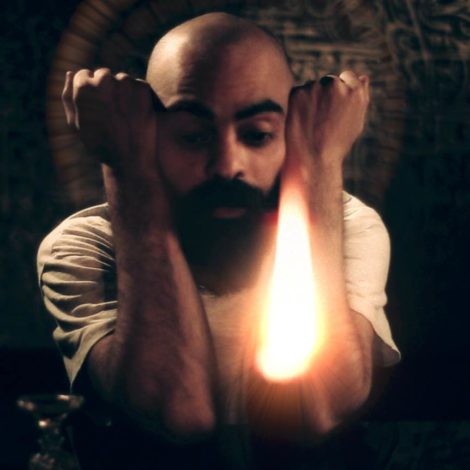
© Deeply Absurd Lucidity – All rights reserved. Via FHIFF.
»Deeply Absurd Lucidity« was the world premiere of a truly international film from Egypt, in Arabic, English, Hebrew with English subtitles, filmed in Germany and Egypt.
Deeply Absurd Lucidity is the winner of the Ficino Award for the best editing at FHIFF 2018. The experimental short film shot of 8 minutes runtime is directed by actor and composer Sammy Sayed. The idea of the film occurred to the director while he was attending a tech-myth production workshop, out of the desire to experiment with sound and visuals in order to create something aesthetically different from the commercial norms.
The result is a film that sets a dark, tense, and surreal atmosphere, that with its Arabic and English subtitles sets a language of its own. That language is similar to the language of dreams, scattered, unconscious, full of meaning, yet stripped of it at the same time.
The film is shot from the perspective of an alien or external entity that looks inside the mind of the protagonist, who is experiencing the conscious and the unconscious simultaneously, trying to make sense out of a rather chaotic experience consisting of symbols that affect him, such as war, religion, history, and mysticism.
2 The Secrets of Alchemy
The second category of films on the First International Hermetic Film Festival 2018 was »The Secrets of Alchemy« and featured three films. The second Sephirah on the Tree of Life would be Chockmah and is about expansion and the creative force. An important ingredient in alchemy most forget about.
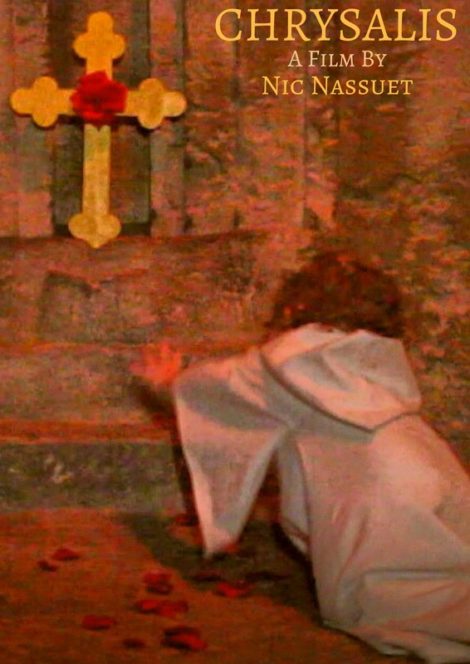
© CHRYSALIS – All rights reserved. Via FHIFF.
CHRYSALIS
This was the first movie, which made me feel a real hermetic vibe on the festival. Shown as European Premiere on the FHIFF, it was featured in the category »The secrets of Alchemy« and won the Vitrol Award for the best experimental film.
The short color movie of about 5 minutes shows the alchemical process of transformation of an army veteran getting back into civil life, embedded deeply in classical western hermetic symbolism best known from the Golden Dawn tradition (and it’s many successors) and hermetic freemasonry.
While the first part shows the soldier’s descending into the blackness, the second part shows the process of transformation and rebirth in a pretty universal matter: Following a woman in a robe making the sign of Harpocrates into the underworld accompanied by the IAO-Formula (Isis, Apophis, Osiris), the journey leads directly into the tombs. It was the first time the tombs of the Rosicrucian Egyptian Museum in San Jose, California have been filmed.
The sign of Osiris the slain and Osiris the risen are self-explanatory followed by an ascent into a new life, symbolized by a newborn child exiting the tomb crying and following the woman now holding the Rose-Cross. Through the Rose Cross the child is born alive again, finding itself in harmony in a green and vibrant garden.
Hollywood based artist Nic Nassuet, born Nick Ortiz-Trammell, turned out to be a great conversation partner on a lot of occult topics. He is nowadays mainly a Neo-folk musician, after leaving his career behind as spy for the US army. Thus, we can suppose, the veteran in the film is Nic himself – as he also admitted for NettlesGarden.com.
Nic had been involved in film and television since early childhood and continued to be active in the acting community, through several boards, the best known may be the Emmy awards committee of the National Academy of Television Arts and Sciences. He appeared in several films as an actor, but also as a writer or in the music department. CHRYSALIS (with caps) is an experimental short film and his first production. He was so nice to hand me out a copy of his debut album, “Eleutherios”, which – positively – surprised me. I recommend the YouTube clips or iTunes to check.
Alchemical Chess (2016)
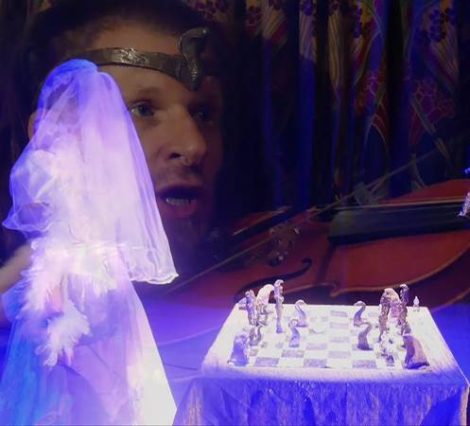
© Alchemical Chess – All rights reserved. Via FHIFF.
»Alchemical Chess« was for the first time shown in Italy at the FHIFF and screened in English with English Subtitles. The film from 2016 with about 8 minutes and 11 seconds was nominated for the Apuleio award for the best animation film, Kenneth award for the best music video, and Jodorowsky award for the best topic at FHIFF 2018. Completely directed, filmed, and produced by occultist and artist Orryelle Defenestrate-Bascule, Alchemical Chess is an Australian short experimental film and music video which depicts a game of chess between alchemical symbols that experience transmutation and become something else. The music itself resembles a bit Current 93, with violin and characteristic speech-singing.
The game itself is a symbol of war, which easily can turn into a game of love. Thus, a game of change that allows the players to transcend their suffering and unite with alchemical archetypes. The ultimate union of these symbols becomes the first condition of existence, a symbol of the embryonic state of spirit in the form of a Cosmic Egg.
Both video and lyrics are completely on Vimeo and can be watched below. The chess figure set used has its own website here.
Entropia (2017)
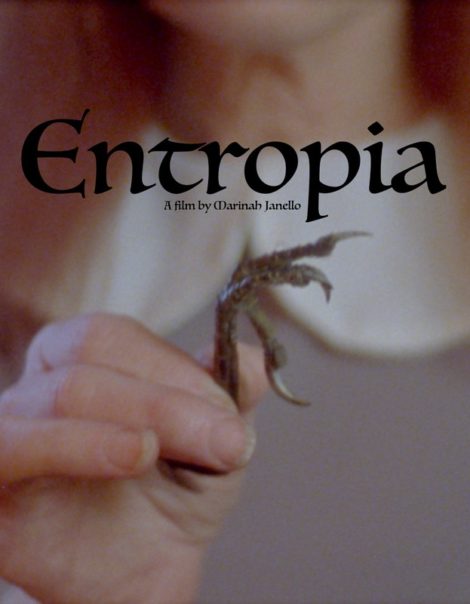
© Entropia – All rights reserved. Via FHIFF.
»Entropia« is one of the three winner of the Audience award at FHIFF 2018, where it had its first screening in Europe. Directed by actress and director Marinah Janello, the 14-minute and 55 seconds lasting short film from 2017 was shot in the United States and the story focuses on a woman’s struggle with aging.
The director summarizes the storyline as »A lonely woman attempts to regain her youth through her taxidermy and spell books«, which is a quite good fit for this horror film with Sissy O’Hara in the key cast. Having no company except for a plethora of preserved and mounted animals of all kinds around her, the woman, obviously trapped in her own mind by repetitive thoughts, engages into obscure recipes and operations in her body in the attempt to preserve her youth, or better: to gain it back.
The movie is an account of one woman’s entropy, or decline into chaos, triggered by her obsession with youth and beauty, which maybe shall compensate her for her lonely and empty life. The film’s main question could be summarized as »How far would you go to turn back time?« or to stay young, and indeed, the film often goes to the limits of aesthetics. And so do people in general in their quest for beauty and youth.
3 Hermetic Society
The third category on the FHIFF 2018 was »Hermetic Society«. My first thoughts for this term were obviously hermetic brotherhoods, such as the Golden Dawn, the Fraternitas Saturni or at least a witchy Coven. But Binah, the Sephirah of Saturn is a form giver and sometimes a strict reminder. In this case it reminded me, all Hermeticism, no matter how advanced it may be, can be traced back to the first shamans in archaic tribes, where it received its first form. »Vestitio«, the second film, reminded me, that most of the time, our consciousness is formed in society, no matter how much spiritual practice we do for ourselves, and that the collective reality formation taking place in society is based on the very same principles.
Above and Below
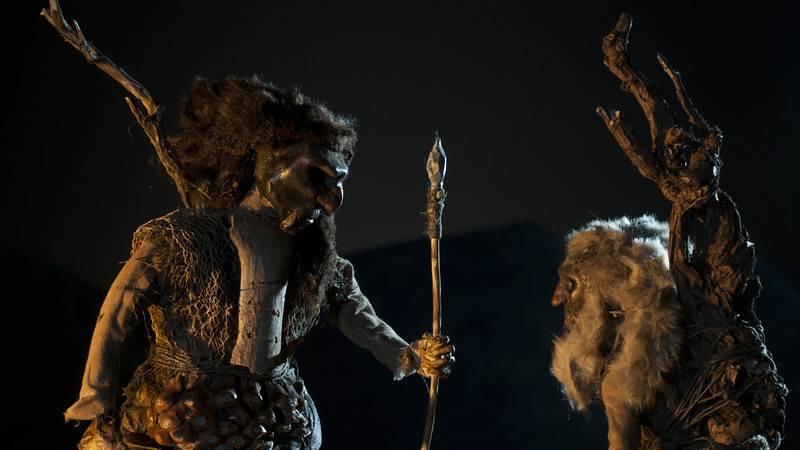
Prehistoric shaman in film scene from Israeli Animation film – Above and Below. © Above and Below – All rights reserved. Via FHIFF.
The 9 minute and 36-second lasting short animation film »Above and Below« (Hebrew: מעל ומתחת) from Israel is the thesis film of the two students Oved Poran and Liron Narunsky in the Screen based Arts department at Bezalel. Completed in 2016 the digital sound only film was shown for the first time in Italy on the FHIFF in the »Hermetic Society« category.
The movie »Above and Below« won the Apuleio Award for the best animation film and shows very beautiful and in an emotional interpretation the ritual burying of an old shaman woman, who farewells her tribe during a parting ritual.
Background for the movie are findings of a prehistoric burial in the cave of Hilazon Tachtit, in Western Galilee in northern Israel. Scientists discovered there in 2008 about 25 skeletons, most of them buried together, and belonging to the Natufian culture (12,000 – 9,000 BC) from the Levante; a transition between hunter and gathering cultures to early farmer societies.
One of the burials stood out, as it belonged to an approximately 1,50-meter tall woman, about 45 years old. Alongside some deformations of the bones, which suggest a walking impairment since birth, the grave goods lead scientists to the conclusion that the grave belonged to a tribal shaman: not less than two weasel skulls, 50 turtle shells, the bones of an eagle wing, a wild boar, and even the bones of a human foot as well as a basalt-bowl should accompany the shaman on her way to the otherworld.
Even though Leore Grosman’s (University of Jerusalem) interpretation of the finding as evidence for an early »voodoo«-cult or shaman burial have not been unchallenged (Mina Evron from the Haifa University described the interpretations as “colorful”) – the film depicts quite well the early stages of shamanism – no matter the culture.
Vestitio

© Vestitio, marvin88production – All rights reserved. Via FHIFF.
»Vestitio« is the winner of the Sulphur award for the best short film at FHIFF 2018. The Italian short film directed by Luca Tartaglia and lasts about 16 minutes and 9 seconds. The film was screened in Italian with English subtitles and shows the moments of a rebellious leader facing the justice system in his public »re-education«. He is followed by a brainwashed mass belonging to a society captivated by a manipulative and everybody equalizing government spanning the globe.
The film borrows symbols such as the AUM-sign from eastern esoterics and visualizes the spark of consciousness during this process. The brainwashed society, which’s individuals do not even realize that they are living a dream woven by someone else can be indeed used as a parallel for the illusional veil of Maya, which can be lifted by enlightenment.
Hermetica Komhata HK320
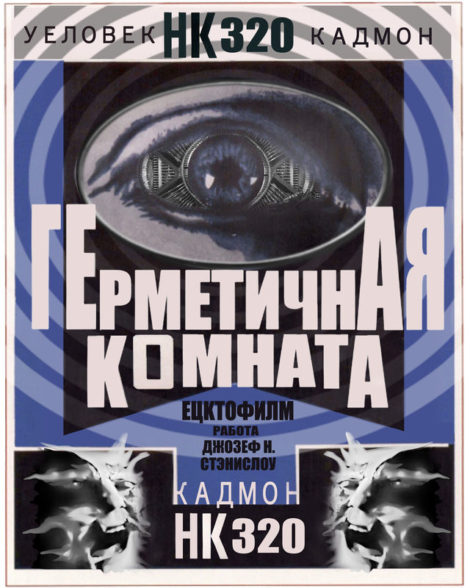
© Hermetica Komhata HK320 – All rights reserved. Via FHIFF.
The film Hermetica Komhata HK320 screened likewise for the first time in Italy at the FHIFF. Languages were Spanish and English with English subtitles.
The approximately 1 hour and 33 minutes lasting feature film »Hermetica Komhata HK320« by Director Ricardo Salvador is somewhere to be situated in between metaphysical retro-Sci-Fi, experimental and surreal. The black and white film was screened in English and Spanish language, with a bit of Enochian, made to sound Russian.
The film presents itself as a documentary, which tries to reconstruct a lost fictional Soviet film (destroyed by the authorities) by the likewise fictitious Dr. Joseph H. Stanislaw. The latter is said to have studied cosmic emanations with the help of Ektoplasma. Destroyed during the siege of Leningrad it was now finally possible to restore the original film and to release the phenomenal esoteric findings of the Soviet-era scientist.
The result is a combination of esoteric, spiritualistic, philosophical speculation, science fiction and experiments on humans, relying heavily on symbolism derived from hermetic and cabalistic manuscripts. Though director Ric Salvador is not a believer in any esoteric current himself, he likes to borrow the symbols to express his own philosophical attempts. One would be the question, how to heal human defects in ways alternative to the classical political or religious approaches. For example, war is seen as a disease, being born from hate, which belongs to the pathologies of man. A condition for which neither religion nor law have found an antidote so far.
The term ectoplasm was coined by French Nobel Prize Winner in Medicine (1913) Charles Robert Richet. Beside his undisputed merits in the research of medicine, he received criticism for being a proponent of Eugenics and racist views.
His various interests spanned from poetry, over history and social sciences to philosophy. However, he spent a considerable amount of time on researching the paranormal.
In this context, he tried to explain the possibility of mediumship in 1894 by postulating a grey-whiteish, sometimes maybe light pink, foaming substance called ectoplasm. Ectoplasm was thought to be a real, material substance stemming from the medium itself and opposed to typical spiritistic ideas (ghosts), which would be involved in many spiritistic phenomena such as materializations. Usually very sensible to light it could be barely observed, except for darkened rooms.
Ectoplasm did not make it into science. So far all evidences were found to be not credible or even fraudulent. However, ectoplasm made it into popular culture (Ghostbusters) and into spiritistic and even some occult literature around the beginning of the 20th century.
Important for Komhata HK320 is, that Dr. Joseph H. Stanislaw studied the »influence of cosmic emanations on the human mind, through his experiments with a film of Ectoplasmic sensitivity«.
I enjoyed the film a lot, which during the festival won the Mercure Award for the best picture, the Eco Award for the best research and the Jodorowsky Award for the best topic. Likewise, meeting with the crew of the film at the afterparty turned out to be worthwhile and enjoyable. A fun fact is that during the film, some sound samples supposed to be Russian actually contain Enochian, the angelic language known from 16th-century occultist John Dee. The team readily admitted that they found it just easier than learning the Russian grammar, which I can confirm comes not always in handy. From an occult point of view, a good choice anyways 😀
Stella Erratica

© Stella Erratica – All rights reserved. Via FHIFF.
»Stella Erratica« was nominated for the Vitriol Award for the best experimental film and the Atalanta award for the best music at FHIFF 2018, where it also had its Italian premiere. The 9 minutes and 25 seconds lasting movie directed by Ben Barton was shot in the UK and screened in English.
The film had a budget of an estimated £3,000, but was lucky to use requisites from David Bowie’s “Blackstar” music video. Hand-editing was used to obtain the vintage style of the movie, which otherwise is better to be described as science fiction. The film’s vintage visual effects look authentic.
The sci-fi experimental film had its premiere at the Cannes film festival and shows the journey of an astronaut to a distant planet, which seems lonely and vast. The only »hermetic moment« is probably the appearance of a unicursal hexagram, as probably most popularized through Aleister Crowley’s »Thelema«. However, the question whether we are alone in space or if the real monsters are actually already among us remains interesting.
4 Kabbalah and Antiquity
The fourth category of the festival was »Kabbalah and Antiquity« – it is easy to relate this to Chesed, the fourth Sephirah, as Jupiter is the order bringing principle. Just as the Kabbalah and the esoteric currents of antiquity gave an order to all occult knowledge until today.
Niggun
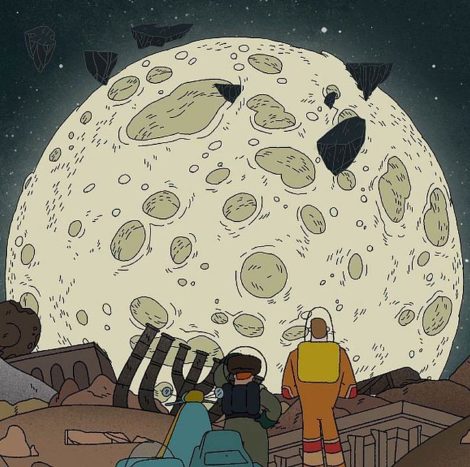
© NIGGUN – All rights reserved. Via FHIFF.
Nominated for the Apuleio award for the best animation film and the Atalanta award for the best music at FHIFF 2018, Niggun is a short 2D animation film from Israel directed by Yoni Salmon. The film is entirely in Hebrew and was screened with English subtitles. In the 12 minutes and 25 seconds lasting movie, a Rabbi and an Archaeologist from the faraway future each search for their place of origin, Earth.
They only find fragments of it that survived in the form of symbols, one of which is the city of Jerusalem, which the Rabbi was hopeful of finding. The name of the movie, Niggun, refers to the religious Jewish song of worship which may hint towards the ideal the two characters are looking for that just like music, is not found in matter, but it is just as real and acts on a physical level.
The style of animation alongside the subtle reference to a spiritual enlightenment is representative of the innocence and naivety of someone who seeks the answers already within them somewhere at their origins or outside of them, in the material world. The film treats the Kabbalah from a traditional Jewish, religious perspective, but the symbolism in the film is deep and intentional. »I am a religious jew and I find meaning in animation and pop-culture« declared Yoni Salmon for NettlesGarden.com and we agreed to follow up shortly with an interview on the similarities and differences between the traditional Jewish and the occidental, hermetic Kabbalah. Meanwhile, we strongly recommend the extensive official website for the film.
SHIVTA (2018)

© SHIVTA – All rights reserved. Via FHIFF.
»Shivta« is yet another film from Israel, the winner of the Audience award and Black Lion award for the best web series at FHIFF 2018, where it had its Italian premiere. The short experimental student film was shot in Israel and is directed by Or Meir Schraiber, who also appears in the key cast.
The genre of the film can be best described as experimental, dance and musical short film without dialogues and shows two dancing travelers in »Shivta«, the ruins of an old city on the former spice route in the »Negev desert« of southern Israel. Shivta belongs since 2005 to the UNESCO World Heritage and may have been a Nabataean town from biblical times or a Byzantine colony.
Accordingly, the movie explores the journey of the two dancers in the desert, after a strange door appears out of nowhere or »like a Fata-morgana«. travelers who are tempted by a mirage in the desert which comes in the form of Fata-Morgana. After entering the door, they find themselves on the site of Shivta, under the musical spell of an oriental fortune teller.
Agadah
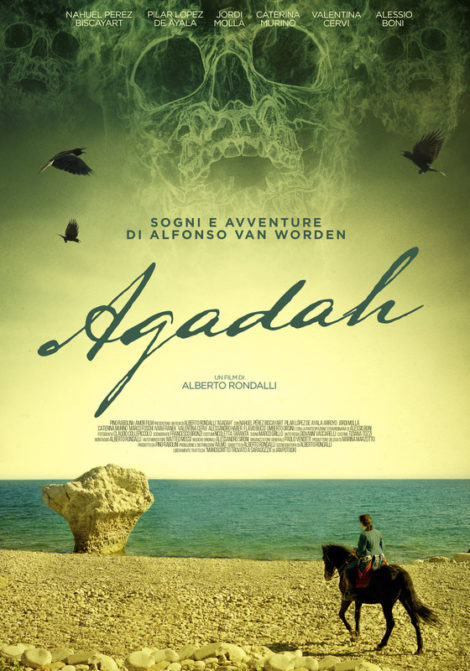
© Agadah – All rights reserved. Via FHIFF.
»Agadah« (2017) is an Italian adventure film of 126 minutes length in French, Italian, Spanish and was screened with English Subtitles. As I am not very into experimental movies or movies per se, this was probably the film I enjoyed the most.
The name itself is derived from the cabalistic term Aggadah, which means story, lore, legend, saying or collection. Often it refers to a collection of (rabbinic) texts, which are based on binding doctrines (the Torah or Talmud for example), but not binding doctrines themselves, and illustrate morals, advice, and teachings on all matters of life in historic or folkloric anecdotes.
The film, by director Alberto Rondalli, sometimes also named an 18th-century Decameron, is based loosely on the French novel »The Manuscript Found in Saragossa« by Polish writer Count Jan Potocki.
The movie starts showing Count Potocki writing his novel, while a young Bourbon officer decides to cross the haunted Murge plateau, or »Altopiano delle Murge« in Italian, to reach his regiment on the way to Naples.
The journey is divided in 10 days, which correlate to the ten sephiroth of the cabalistic tree of life (the book features 66 days) and mark a cycle of initiation into a secret society, probably masonry, as Potocki was a mason himself.
The 10 days – and especially nights – are full of unusual happenings and encounters, floating between the real world and the world of dreams, featuring erotic encounters with Mohammedan princesses, which turn out to be demons, meetings with cabalists or adventures in a gypsy camp.
The film ends with the death of the novelist, who committed suicide in the very same way as Count Jan Potocki killed himself in 1815. At the FHIFF »Agadah« won the Caduceus Award for the best feature film.
5 Gnosis: Good vs Evil
The fifth category on the FHIFF was »Gnosis: Good vs. Evil« and featured one of my favorite films – »Metanoia, Metanoia«. For the ancient Gnostic, her spiritual quest was a struggle, and as such – it may be easy to relate it to Geburah, the fifth Sephirah, ruled by the planet of Mars.
METANOIA, METANOIA

© METANOIA, METANOIA – All rights reserved. Via FHIFF.
»Metanoia, Metanoia« had its European premiere at the FHIFF and was nominated for the Agrippa award for the best director and the Sulphur award for the best short film. The 15-minute lasting movie was directed by filmmaker Joshua Alexander Matteo and shot in the United States. As already mentioned in my last post, this movie was one of my favorites.
The movie is fascinating in many regards. While the plot itself can be told shortly, the various layers of meaning attached to the movie cannot. So first the plot: a young woman discovers three chests in the woods and henceforth wanders New York City experiencing frightening and strange situations, in a music only film, with the atmosphere of classic Italian horror movies.
Indeed, director Matteo’s initial intention was to create a horror or fantasy thriller, Italian style such as the movie »Inferno« by Dario Argento’s (the second movie of the Three Mothers trilogy).
However, during his research, Matteo came into contact with the world of Gnosticism. And while the plot remained the same, he started to add various gnostic symbols to it, based on a real sound research, which made me decide to feature soon an entire stand-alone article on the film »Metanoia, Metanoia«, its mythological background and the director’s thought about it. Anyways, let’s keep on with the short version for today.
Already the title of the movie »Metanoia« refers to the aim of all Gnosis. Usually translated as change, atonement, spiritual conversion or repentance, this ancient Greek expression in Gnosis also referred to the liberation from the flesh’s sin and the return of the divine spark out of »Kenoma«, the empty, physical world, into the shining ocean of light »Pleroma«, the realm of the true God. It can be thus compared to what Eastern religions call »enlightenment« and the liberation from »Samsara« and this is indeed also the short interpretation of Matteo for his film: »Becoming Enlighted, fearing the unknown, and making a leap of faith to move on into the next world« as he declares for NettlesGarden.com. Without a good knowledge of Gnostic symbolism, this may be however hard to discover, after all, the footage is seemingly a thriller.
For the film, Matteo sought inspiration and motifs from »The Hymn of the Pearl«, the Archons, and mainly Sophia. But he inspired himself also by the Eleusinian mysteries – »not quite Gnostic«, as he admits further in a recent conversation.
Otherwise, the film sticks strictly to the symbolism. Even the boxes the young woman and protagonist of the film finds, contain real Gnostic artifacts: a coin of Abraxas and a chart of Sophia from the »Secret Symbols of the Rosicrucians« book.
For the director, the film brought him into contact with Gnosticism in a life-changing manner, as he says. Not being an organized religion, it is something he can resonate with, and now (re-)discovers everywhere. My take on this: How not?! Gnosticism, after all, is one of the most important spiritual and cultural heritage we have in the Occident, being rooted in classical antiquity, a vibrant part of early Christianity until the middle ages, and since then continuing to live in alchemical and occult traditions of the west, with huge impact on theosophy, Rosicrucians and all other currents thereof and even the psychology of C.G. Jung. Parallels to Buddhism are striking.
But let us end this review for now with some trivia, as narrated by the director: »The Hymn of the Pearl speaks about how we are all divine light that has forgotten this when we came into this world. We must claim the pearl from the dragon and remember our divine origin to return to the light. I was surprised by this because I had already styled by archon with a pearl! This became a perfect plot device«.
Joshua Matteo was so nice to grant an exclusive permission To NettlesGarden.com to show the Grand Central scene, so you can discover the symbols on your own.
To Help the Human Eye (2017)

© To Help the Human Eye – All rights reserved. Via FHIFF.
»To Help the Human Eye«, the winner of the Agrippa award for the best director at FHIFF 2018, where it was screened for the first time in Italy, in Spanish language with English subtitles. »Ayudar al ojo humano« , the original Spanish film and project title, is a feature film shot in Spain and India, directed by Velasco Broca and Julian Genisson. The film with a total runtime of 1 hour and 23 minutes is constructed as an anthology consisting 3 short films: »New Altar« and »Dioses Autonomicos« by Velasco Broca, and »The Mugging Nurse« by Julian Genisson.
The story follows a priest whose Spanish grandfather, also a priest, was cursed in India in the early 20th century. The curse would follow his descendants, including his grandson, who experiences exile and surrenders to the Atlantic Ocean.
In his initiatic journey triggered by this curse, the priest has to face a series of symbolic antagonists, such as archons, insects, wizards, thugs, and even the Devil in a stylized film that arranged these symbols to compose a dramatic and surreal dream-like visual.
6 Healing and Science
The sixth category on the FHIFF 2018 was »Healing and Science«. And indeed, both films in this category showed popular attempts to somehow reconcile esoteric thinking, healing and science. As Tiphareth, the sixth Sephirah of Synthesis, we may go with the numbering.
Grand Tour Omeopatitco
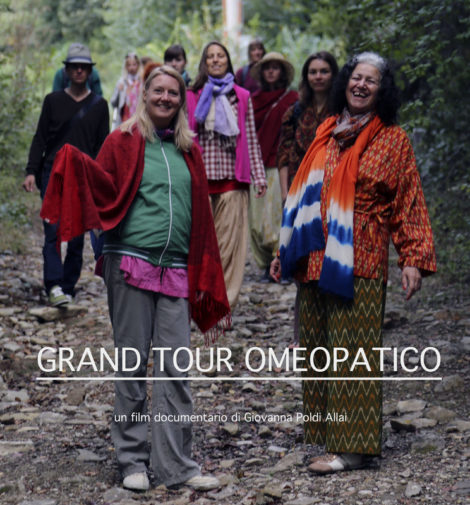
© Grand Tour Omeopatico – All rights reserved. Via FHIFF.
»Grand Tour Omeopatico« is the special mention winner at FHIFF 2018. The Italian documentary of about one hour runtime directed by Giovanna Poldi Allai follows the journey of the master of “The awakening of the healer” school of homeopathy, Annalisa Adami and homeopath Nathanael Schwartz.
Master Annalisa Adami is an Italian woman who became a successful homeopathy practitioner, Guru, and healer in Berlin, Germany. Through the lessons she shares in this documentary, the audience is able to acquire a deeper understanding of her healing practice and gain insight into her healer’s way of life and the journey she makes.
The colorful footage of her journey in places like Italy and Bali, introduces the audience to an exotic culture focused on health and healing which doesn’t look at alternative medicine as a one-time solution, but as a way of living a simple life consciously in gratitude and joy.
For me, personally, the film is a reminder how old hermetic ideas carry on to live in modern alternative lifestyle approaches, even though, in homeopathic doses.
Vibration: Symphony of Life
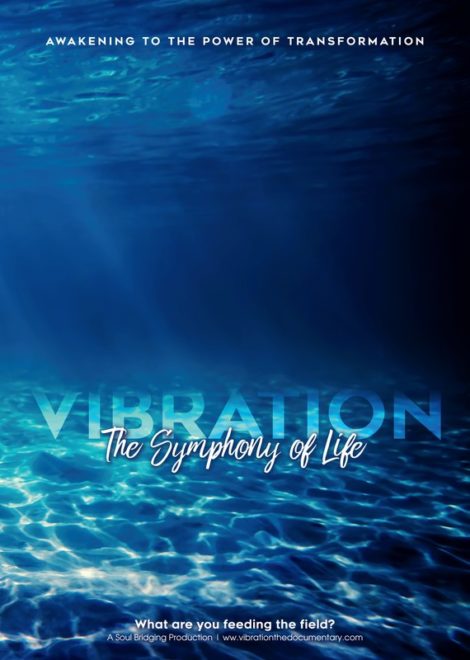
© Vibration: The Symphony of Life – All rights reserved. Via FHIFF.
The special mention winner at FHIFF 2018, Vibration: »The Symphony of Life« is a documentary filmed in the United Stated and directed by Justin Wilkinson. The documentary had its European premiere at the Hermetic Film Festival 2018 in Venice. Lasting nearly an hour (58 minutes), the documentary is an attempt to find place esoteric ideas in a scientific paradigm with »vibrations«, which are declared a »law«.
Thus, the documentary features various experts who explain how vibration can affect our physical bodies, hearts, and how it can also affect us mentally. Learning about how vibration works can potentially help people to use it in order to attain happiness, spiritual enlightenment and more. This synthesis of science and mysticism is said to be able to produce practical applications for those who want to make good use of vibration in their lives, and some of these techniques are presented in the documentary.
“The Symphony of Life” in the title refers to how one’s individual vibration participates in the “greater symphony of life”, by receiving and transmitting notes and frequencies that alter their state of being. Being conscious of this can not only rise one’s individual vibration but also contribute in rising the world’s vibration. A trailer is available below, while the full video can be purchased on the film’s website.
7 Religious Strains
The seventh category on the festival »Religious strains« had a strong focus on the East, this year. The first film »The Blacksmith« is a spiritual journey into Ukraine, while the second film, »Christ/el« contains at least a few memories of Eastern Germany. The third film finally, shows a rare religious ritual from Armenia. The relation to the seventh sephirah, Netzach, ruled by Venus, came to me via the principle of aesthetics. There was a lot of beauty in »The Blacksmith« and »The Elegy in Light«.
The Blacksmith
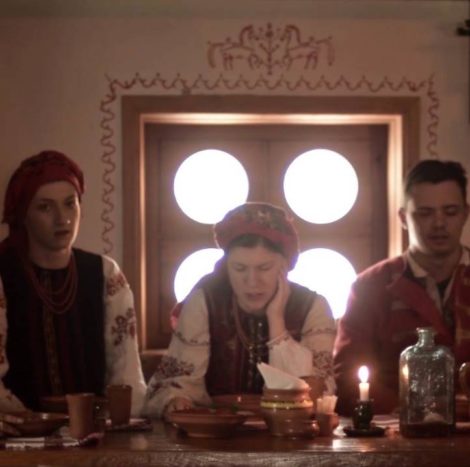
© The Blacksmith – All rights reserved. Via FHIFF.
The German 30-minute film »The Blacksmith« by directors Ivan Andrianov and Nina Gudme was filmed in Ukraine, had its Italian premiere at the FHIFF in Venice (World premier was at Cannes Film Festival) and screened in Ukrainian with English subtitles. Both directors are students at the Film University Babelsberg Konrad Wolf in Germany.
Located on the Ukrainian countryside around Kiev blacksmith Sergey explains his worldview to his student while teaching him the process of hammering and forging as they create a new piece of work on the anvil.
Not only their working style and the environment is rural but set in a stage which so far has suffered little exposure to modern lifestyle. Also, the mentality is in many regards still untouched by modern life. One of the most obvious scenes in this regard is the Blacksmith’s comments about his feeling of time and the right timing. The entire surroundings, starting with the landscape and ending with the people and their lifestyle merge perfectly well with what for the most western ears is archaic sound, but which in many parts of Eastern Europe still is traditional popular music.
The directors intent was to show the »closed, rich and worldwide unknown culture of Ukraine … revealing its essence of strength and resistance«. I enjoyed the music and the rural images a lot, it reminded me often of Transylvania before joining the EU. This makes some sense, both Romania and Ukraine share a part of the Carpathians.
The film won the Atalanta Award for the best music at the FHIFF.
CHRIST/EL (A.Grützner)
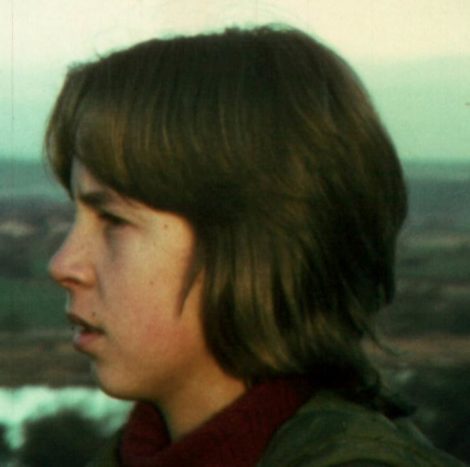
© Christ/El. – All rights reserved. Via FHIFF.
»Christ/el« was nominated for the Pelican award for the best short documentary and the Rosenkreuz award for the best foreign documentary at FHIFF 2018. The short German documentary is directed by independent filmmaker, Andreas Grutzner, filmed in Super8 shooting format and featuring footage from 1975-1977 tapes.
The story explores for 8 minutes and 39 seconds the world of a young boy, his family life, and his memories of coming of age, but mainly evolving around questions regarding belief. Director Andreas Grützner reflects various attempts during his life to find his home in Christianity, but is also in a large part, a reflection on his parents and their relation to belief. Accordingly, the title»Christ/el« refers with the first part to someone who is a Christian, and if read entirely to the name Christel,his mother. The ironic point of the short film is that latter had been a strict believer all her life but died as a doubter (or maybe just kept the secret of her belief so hermetically well).
Elegy in Light
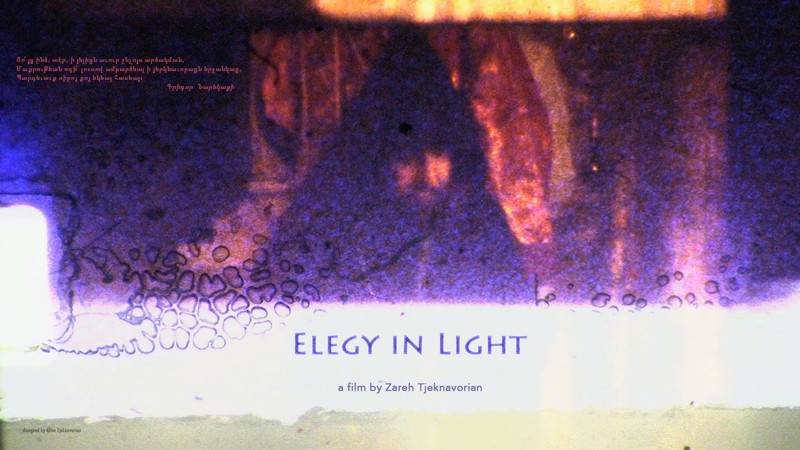
© Elegy in Light – All rights reserved. Via FHIFF.
Winner of the Rosenkreuz award for the best foreign documentary, »Elegy in Light« is a short documentary with 10 minutes runtime directed by Zareh Tjeknavorian in Armenia. The ethnographic film contains footage that documented the funeral of Catholicos Vazgen I, the Supreme Patriarch of All Armenians, who died on August 18, 1994.
An important figure in their culture, Vazgen I dedicated much of his life to renewing ancient Armenian churches and attempted to reunite both wings of Armenian Christianity. The film shows the »rarely seen rite of the Armenian Church with the sound of monastic ritual chant« (Zareh Tjeknavorian) which is a passing ceremony that interprets the soul’s metamorphosis and transition into the next world.
This makes it a valuable insight into Armenian Christian culture. Additionally, the film leaves an impression on how we remember our history and meditate on life and death while also preserving what is left of “Near Eastern religious tradition” that dates back to the early 4th century.
8 Magic and Witchcraft
This category featured three films: »Left Hand Path«, which was shown for the first time outside of Canada, »Modern Craft« and »Jenny loves Satan«, which were shown for the first time in Italy. For me, they were obviously among the most interesting films on the festival. Being the eighth category, we can relate it to Hod, the Sephirah of Mercure and Hermes, the androgyne fathers of our craft.
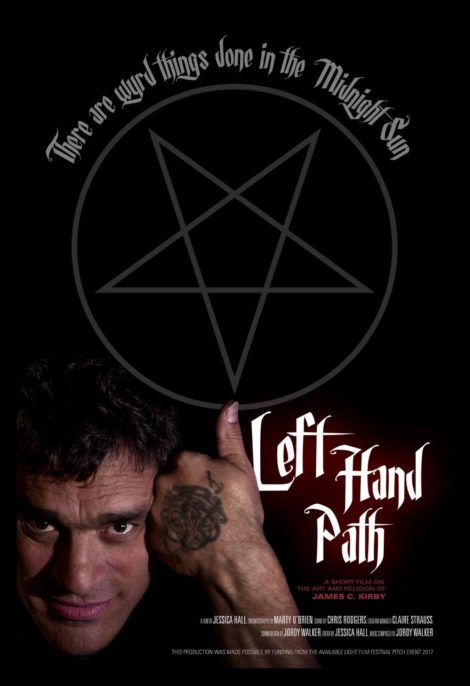
© Left Hand Path – All rights reserved. Via FHIFF
Left Hand Path (2017),
One of my favorites during this FHIFF edition was »Left Hand Path« by Jessica Hall. A documentary featuring the Setian religion of James Carman Kirby. James was an artist from Whitehorse, Yukon, Canada and Magister Templi in the Temple of Set until his death, in late autumn 2017. As far as Nic Nassuet told me, James died on Halloween, after a long illness, and as it seems on his own terms. So basically he died the same way as he had lived his life.
Kirby was a creator of fine jewelry in gold and silver, as well as other rare and precious materials such as gemstones, or ivory. However, he did not work with any animal material with the exception of fossilized Woolly Mammoth Ivory and dinosaur bone. In the film, while working on one of his unique pieces of jewelry James C. Kirby explains the philosophy behind »black magick« as understood by him and probably many members of the Temple of Set. The documentary also shows him in his ceremonial magick altar space, which he explains with the words:
»… So when we do ritual, we act as gods. That’s the purpose of ritual, to make conscious changes to your life, in a very direct fashion. You’re speaking to yourself through yourself, to your highest self. This is my altar and every Setian’s altar will be different. You don’t need an altar, you don’t have to have one. I come from a ritual magic background from Thelema. So I like the ritual aspects of having an altar…«
This was the international premiere of the 14-minute short film and documentary from Canada, filmed in Canada, directed by Jessica Hall. The movie is in English language and has English subtitles, which come in quite welcome in certain passages, such as in the part where a lot of specialty lingo in Greek or Egyptian is used. »Left Hand Path« won the Pelican Award for the best (short) documentary at the FHIFF.
Modern Craft
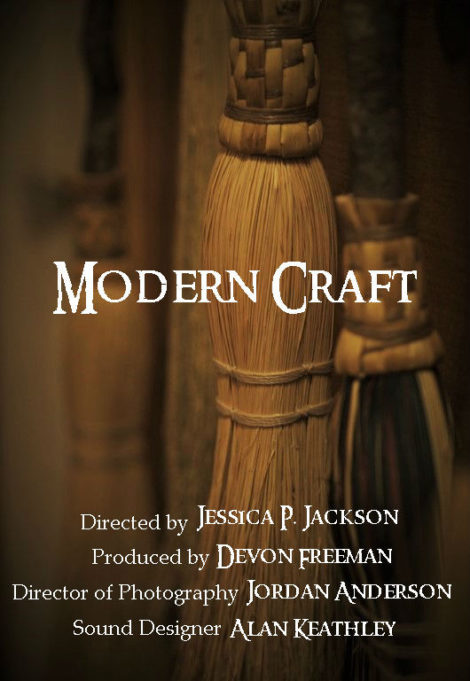
© Modern Craft – All rights reserved. Via FHIFF.
»Modern Craft« is a short documentary with nice, witchy imagery and atmosphere, which contrary to the suggestive film poster and a large part of the scenery does not want to further spread prejudices about witchcraft. Rather, it is director’s Jessica P. Jackson’s aim to decompose stereotypes and to demystify Wicca by showing what it really is: a peaceful and non-offensive religion. Honestly, I have no idea whether she succeeds or not, having been an occultist nearly all my life since childhood. I do not see the problem which some outsiders may have with Wicca in the first place.
Anyways, during the roughly 11-minute lasting short-film, the spectator comes in touch with Wicca through a Wiccan High-priestess, a young newcomer Wiccan and a Christian, who is studying this neo-pagan religion. The High Priestess, Lady Passion, is a third-degree Gardnerian Elder in the Californian Line and High Priestess of Coven Oldenwilde in Asheville, NC.
By real name Dixie Deerman and of Northern Irish ancestry, Lady Passion has been a »public witch« since 1976, counsels clients since 1979, focuses on herbal medicines, divinations, but is also a registered nurse since the late 1980ies. She wrote a total of four books so far: Candle Magic; Simply Savory: Magical & Medieval Recipes; Ask-A-Priestess: Wise Answers From a Real Witch; and last but not least: Pagan Prisoner Advocate’s Guide.
The Film from the United States was screened in English, filmed in the US and had its premiere in Italy on the FHIFF.
Jenny loves Satan (2017)
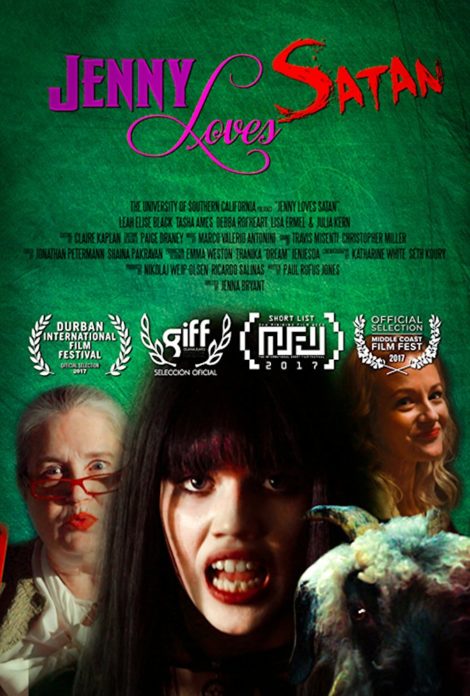
© JENNY LOVES SATAN – All rights reserved. Via FHIFF.
»Jenny Loves Satan« is a short film of 14 minutes and 21 seconds. The movie was produced by the University of Southern California and realized by students: Jenna Bryant as Director, Paul Jones as writer; Nikolaj Wejp-Olsen and Ricardo Salinas as producers.
The 12-year old teenager Jenny, played by Leah Black, decides to become Satanist within an act of well-through-thought rebellion:
»I know that you are just simply a representation of man’s carnal nature and a symbolic rejection of false deities« sounds Jenny’s satanic prayer in her penumbrous children-room, set against the background of a wall with pink wallpapers. »I didn’t think you were real…« she adds.
But soon she will find out, that her »symbolical rejection of false deities« quickly exposes and overburdens the quite limited capacities of many in the world around her. Not only other kids at school, who much her, but »rational« adults, such as parents and a teacher at the school, which lets her know, that religious liberty is for everyone, except for Satanists.
During the movie, Satan hears Jenny’s call and appears – played by Julia Kern – to offer help. I laughed and enjoyed the movie so much. Maybe because it compensated me post-hoc for all the experiences with irrational teachers, and other themselves well-educated deeming persons in society I had to deal with when I was the same age as Jenny. I am not sure if this was what the filmmakers were thinking about while filming »Jenny Loves Satan«, but it is my take on the film, which won the Audience Award on the FHIFF 2018.
9 Spritism and Rituals
The ninth category of the FHIFF 2018 dealt mostly with spiritism this year, and »Spiritism and Rituals« can be related to Yesod, the sephirah of the moon, subconscious and dreams.
The strange case of Emily Grey (2016)

© The strange case of Emily Grey – All rights reserved. Via FHIFF
The Italian short horror film of 9 minutes and 44 seconds in color and Full HD was screened in English with Italian subtitles.
It shows spiritistic medium Emily Grey during a seance, in which she breaks the circle due to the unprofessionalism of the attendees. However, as a consequence, she gets into trouble with an evil spirit which was attracted during the seance.
Perhaps what is most interesting about the story is that it differs from typical “seance” based film in that, in this story, the entity starts haunting Emily, the experienced spiritist, and not some unassuming victim who was a mere participant in a séance conducted by someone else, who is often, left untouched.
The director Luigi Parisi is a declared lover of fantasy, horror movies and thrillers and names Hitchcock and Polansky among his favorites. Main inspiration, however, were the Italians Dario Argento and Mario Bava. The movie »The strange case of Emily Grey« was nominated for the »Sulphur« Award for the best short film and for the »Black-Lion« award.
Holy Terrors (2017)
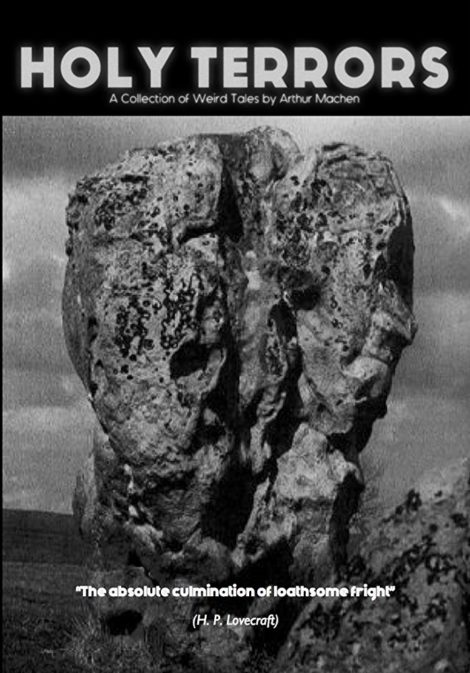
© Holy Terrors – All rights reserved. Via FHIFF.
»Holy Terrors« or »Six Weird Tales by Arthur Machen« is a digital feature film from the United Kingdom, for the first time shown in Italy and directed by Mark Goodall and Julian Butler. Best described with the genres Horror, Supernatural and Ghost stories the about 1 hour and 14 minutes lasting film is mostly black and white but has also some scenes in color.
A detailed review with an extensive background is available here at folkhorrorrevival.com, but let’s give a short overview and some words about Arthur (Jones) Machen’s relation to the occult and the hermetic sciences: Born 1863 in Wales as Arthur Llewellyn Jones, the later »Machen« became a popular writer of fantastic and horror stories, who influenced among others H.P Lovecraft. However, he was also a member of The Hermetic Order of the Golden Dawn but seemed to prefer the safe haven of the Anglican church in the long-run.
Nevertheless, he had been a close friend with A.E. Waite and the interest in the occult and supernatural have been a constant in both his life and work. The literary breakthrough in 1894 came with the horror novel »The Great God Pan« on the coexistence of the real world and a mythological Celtic-roman parallel-world. Even though Machen is said to have been a down-to-earth person, who would not just readily believe in the supernatural, mythology and the fantastic always remained a constant in his writings.
The film captures the elegiac style of his stories, was well received by fans and won the Special Mention Award at the FHIFF 2018.
The Tale of the Idiot (2017)
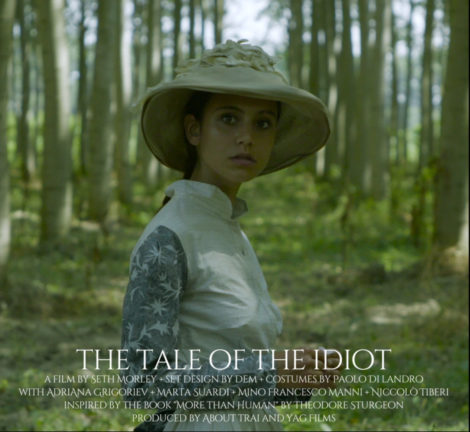
© The tale of the Idiot – All rights reserved. Via FHIFF.
»The Tale of the Idiot« is an Italian experimental short film of 35 minutes directed by Seth Morley. The film re-interprets and tells the story of the Idiot, a character from a science fiction novel, »More than Human« by Theodore Sturgeon, which inspired the movie. »The Tale of the Idiot« had its Italian Premiere at the FHIFF and was screened with English subtitles. The film is winner of the special mention award at FHIFF 2018.
In the book, the Idiot has never experienced real human connection, despite the fact that he has telepathic abilities. In the movie, Evelin lives in an isolated home with her father and sister and since her mother died, no one left or entered the property.
Her story is that of coming of age in a sterile environment, awakening a desire for freedom and exploration within her. While this is happening, the Idiot leaves his home behind in order to seek a girl he has met in his dreams.
10 Myth and Demons
The tenth category was Myth and demons. While the film »Hellsaga« revives old Norse and Icelandic mythology, we meet in the film »TAU« a daemon in the original sense of the word. Maybe the 10th category »Myth and Demons« relates to Malkuth, the earthly Sephirah of manifestation, because »Hellsaga« is a prime example of how earthly the ancient gods in many pantheons actually were. And with »TAU«, we meet a daemon walking the earth, and commenting the life in a modern city.
Hellsaga
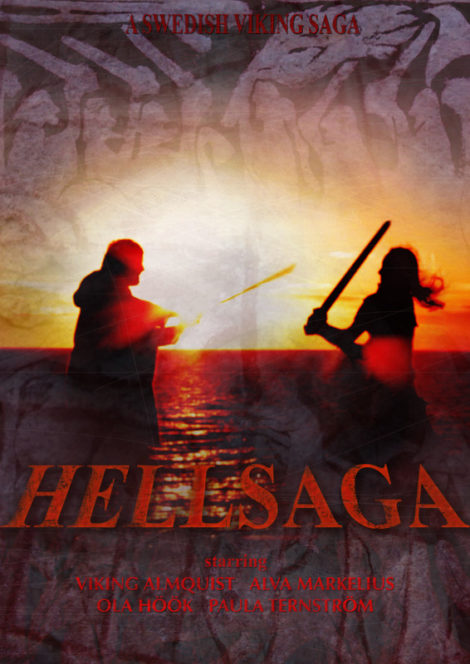
© Hellsaga – All rights reserved. Via FHIFF.
»Hellsaga« or »A Swedish Viking Saga« is a 12-minute color-short film by director Viking Almquist from Sweden, and was screened in Swedish with English subtitles on the FHIFF.
For the first time shown in Italy, we could see the story of »a young warrior [who] seeks the wisdom of the gods« in this historical adventure film from 2017.
The film claims to be “based on the Poetic Edda, a tale of magic and myth”. What we see is a Wanderer without a name (played by Viking Almquist himself), clashing with a »black viking«, seeking advice from his mother, meeting a troll in the woods, talking to the dead at the beach before meeting again with the Black Viking for the final battle…
We see some runes and the encounter with the troll in the woods seems very much inspired by the classic battles of knowledge in riddle form between Odin and the giants. In particular, it reminded me of the encounter between Odin and Vafthruthnir in the Vafthruthnirmol.
Also in other regards, the film incorporated historical references to archeological Viking findings, such as the helmet of the Black Viking and the horns of troll.
Thrill over Fear
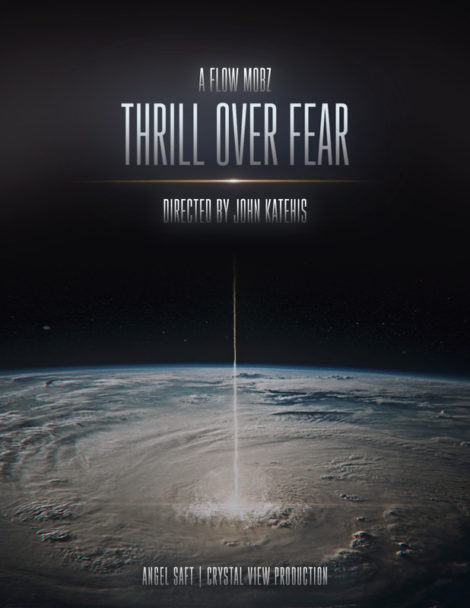
© Thrill Over Fear – All rights reserved. Via FHIFF.
Winner of the Kenneth award for the best music video at FHIFF 2018, »Thrill Over Fear« is a Greek music video of the music duo A Flow Mobz, directed by John Katehis. The video’s emphasis is on facing fears and challenges without being altered by the battle against them.
The main symbol present in the video is the serpent-headed gorgon Medusa, who in the Greek myths was able to petrify with her look and turn people into stone. Given the myth and the visuals of Medusa being petrified herself in the video, it would be interesting to assume that she was petrified by her own eyes, which would be a great metaphor for facing inner demons.
Ultimately, the stone cracks and she is experiencing a form of “enlightenment”, which means that she was able to overcome the paralyzing effect of her fears. The other imagery in the video suggests that outside the inner struggles, there are bigger challenges, but winning over inner battles is one step closer to winning the entire war.
TAU, the daemon and the city

© Tau, the daemon and the city – All rights reserved. Via FHIFF.
»TAU, the Daemon and the City« was the last film shown on the 2018 edition of the FHIFF and won 3 awards: The Fludd Award for the best cinematography, the Cagliostro Award for the best storytelling and the Jury Award. It was screened in Catalan with English subtitles and had its international premiere on the FHIFF.
»Tau is, at once, a fiction film on spirits, a documentary on the passing of time in a small town and a portrait of Catalan traditional culture«. The spectator witnesses a fictional portrait of the Catalan city Taragonna, shown through the eyes of a daemon, living in a parallel world, which is both transcending and surrounding our human world.
The slightly over 2 hours lasting film (123 minutes) is comprised of old footage director Gerard Gil collected during the last years, during a time, while he was also working as a cameraman for TV in his hometown.
Or as Gerard Gil declares for NettlesGarden.com:
»I often found myself in a situation where I had to film some images for a program and, meanwhile, I noticed the really interesting images where happening aside. But I couldn’t film them at that moment, since I was working for tv. The film came afterwards, going to the streets on my own, with no preconceptions on what to film, and being completely free with the camera.
It actually took several years of going out to the street in this way to get the footage for the film.«
The story, or voice over, was directly dictated to him by the daemon itself after Gerard had read Plotin’s Enneads. »It’s hard to say whether we have ideas or ideas have us« asks the director of TAU, commenting his work and the process of its creation.
A good question, to end a film festival around the Hermetic tradition, which owns so much to the works of the Platonists.

www.Nettlesgarden.com – The Old Craft


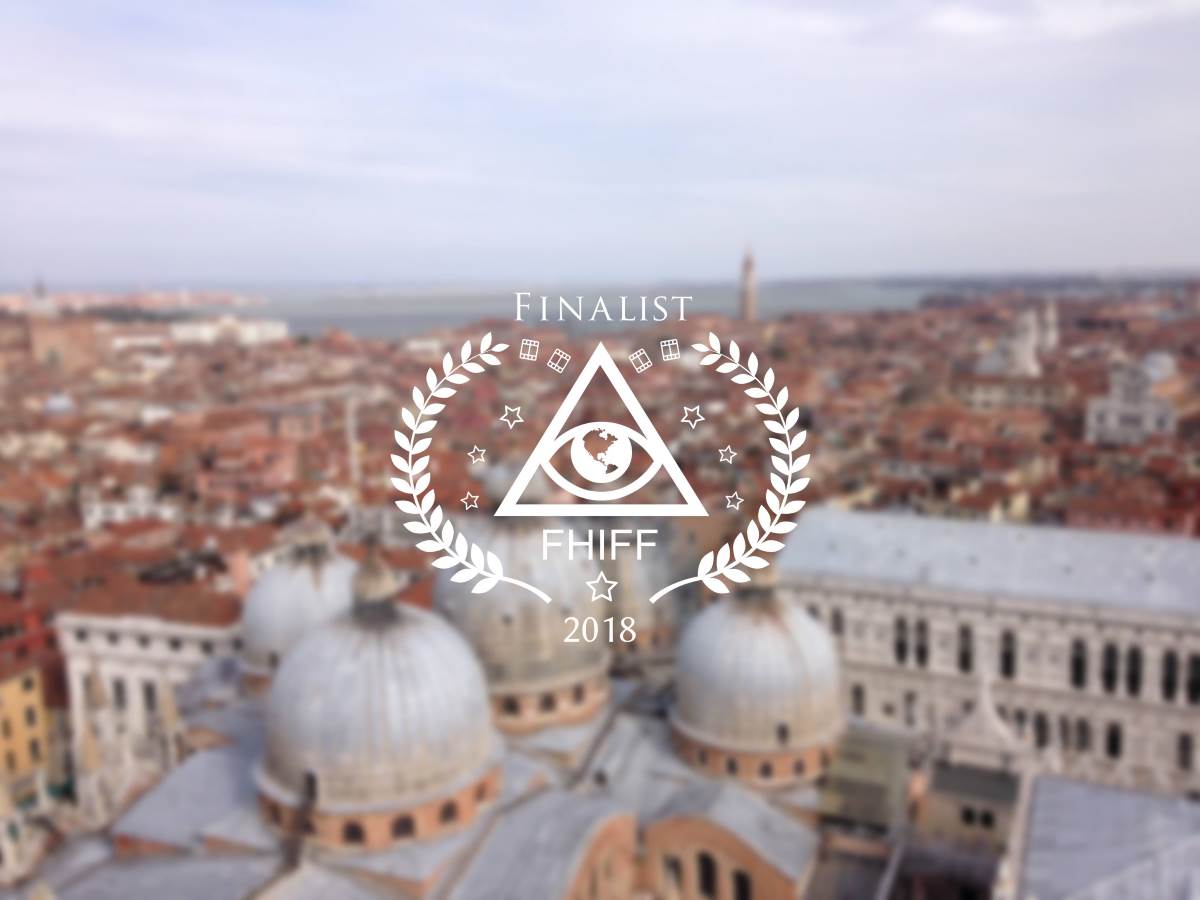
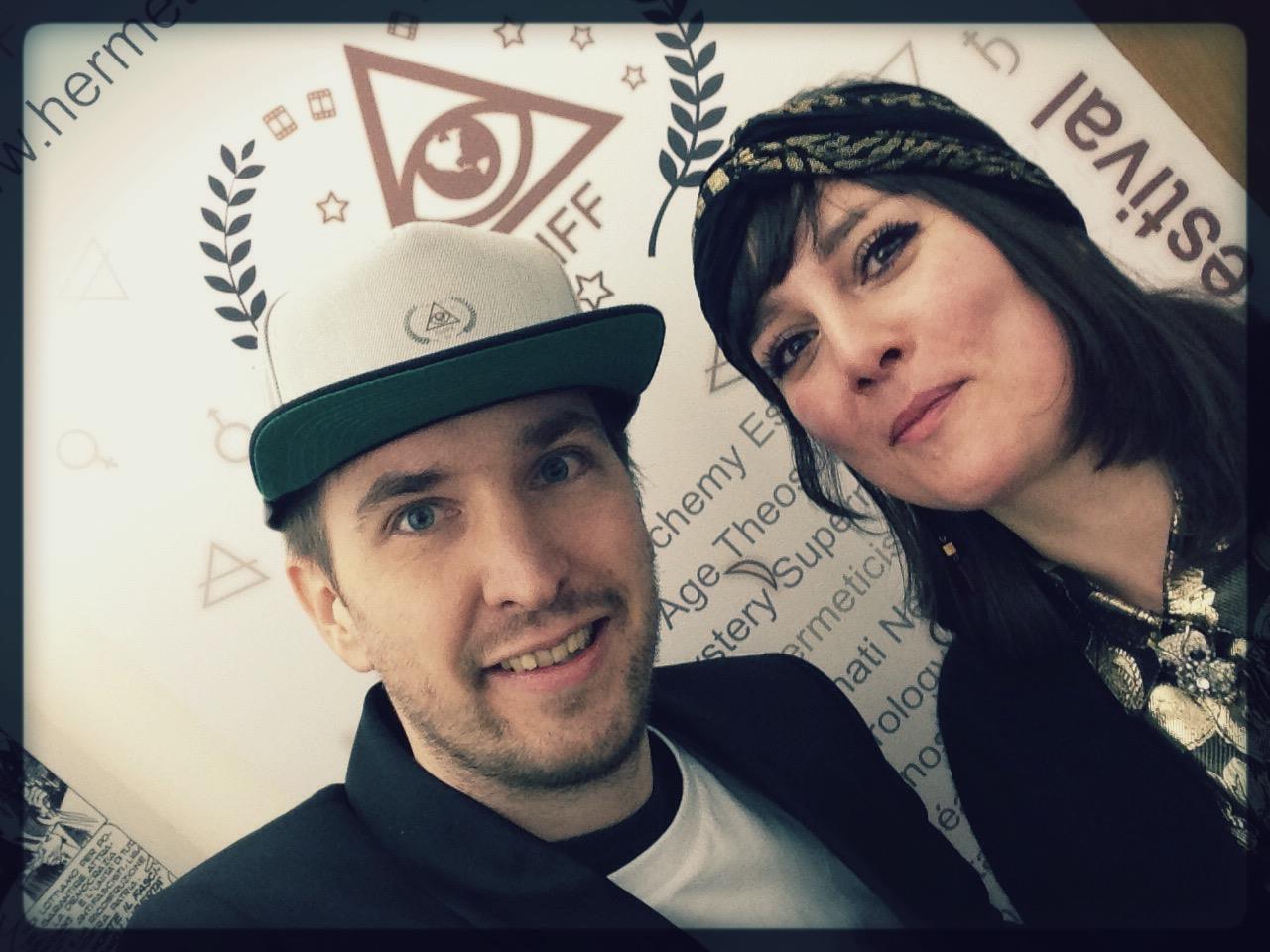
Katherine | February 27, 2019
|
Hi Alexander
Thank you so much for an amazing article. I was wondering how I could watch the films/find them. I did several searched online for several of the titles but having no luck so far I thought best to ask you.
Maybe they each need to be bought individually, I would like to watch all 28! but of course starting with one is already great.
With kind regards
Katherine
Edward | September 19, 2021
|
Hi hey awesome article if you perhaps may have the link for the movies let me know if you got hold of them thanks appreciate ?
Alexander H. | September 20, 2021
|
Hello
many of the movies (and much more) can meanwhile be streamed here on this site: https://occultrama.com/
it was made with the help or implication of some of the hermetic film festival members.